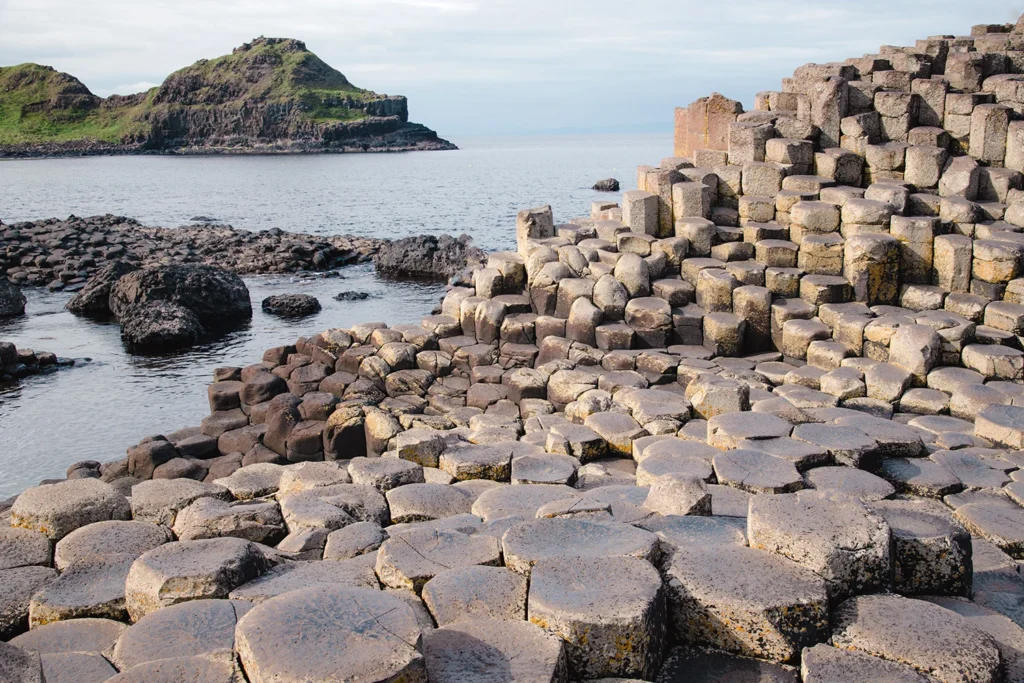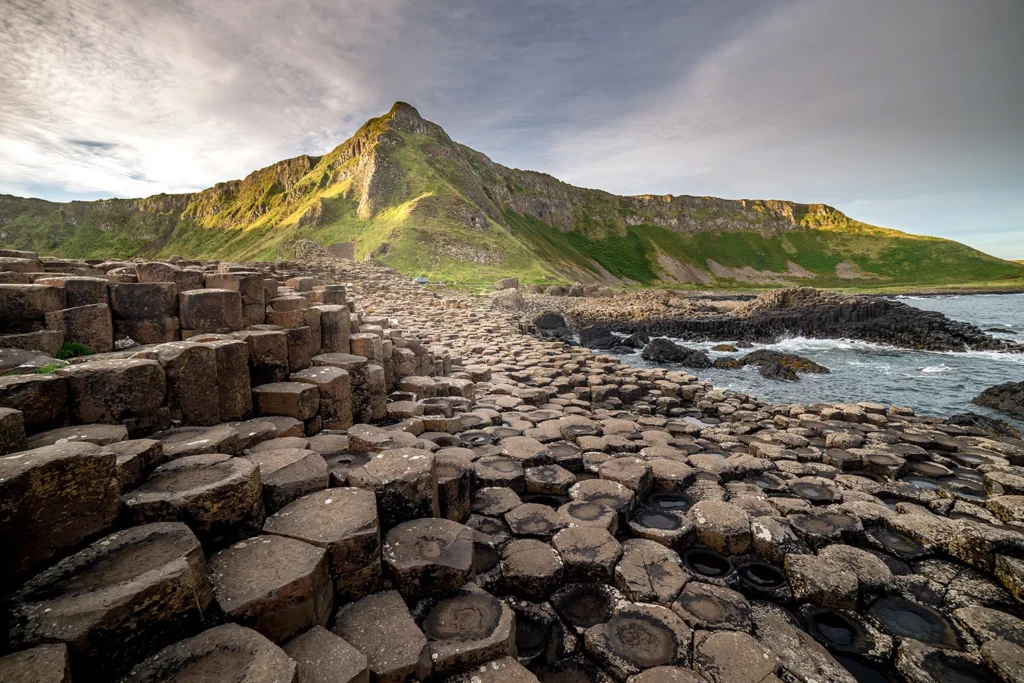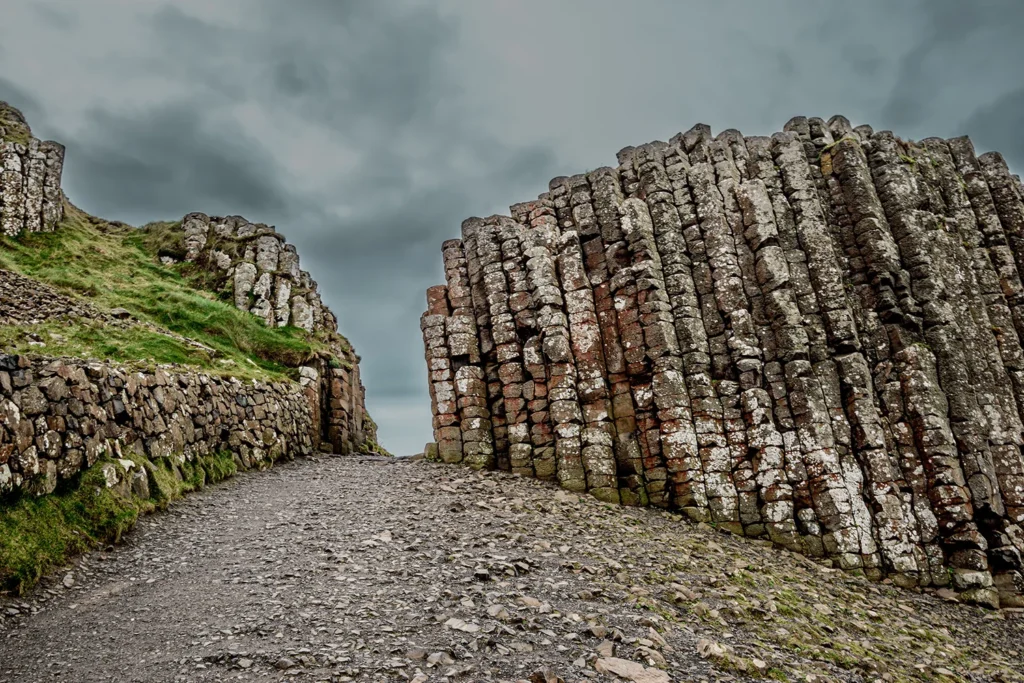On the map of all Northern Ireland, there is only one site that, due to its uniqueness, has earned a place on the UNESCO World Heritage List.
The Giant’s Causeway is located in County Antrim, on the coast of Northern Ireland. The rock formation, discovered in 1692 by the then bishop of Derry, continues to spark curiosity and admiration from tourists around the world. And while Ireland is by no means lacking in picturesque landscapes, this site is the only one in the entire country listed as a UNESCO World Heritage Site.
About the Appearance of the Giant’s Causeway
But what exactly are we talking about? The causeway refers to a type of embankment separating two parts of a body of water. However, this particular one is quite different from all others. It consists of nearly 40,000 basalt columns, whose shapes and tight arrangement form a stepped structure, resembling a honeycomb from above. The average height of the columns is around 2 meters, but some basalt pillars reach up to 12 meters. While the core of the causeway is made up of four-, five-, or six-sided columns, nearby you can also see other basalt rock formations, resembling organs, a camel, or an armchair.
How Was the Giant’s Causeway Formed?
While admiring this unique piece of the Irish coastline, the obvious question eventually comes to mind: How is it possible that such an extraordinary structure is solely the work of Mother Nature? At the time the Giant’s Causeway began to form, Northern Ireland was still connected to North America. Yes, that’s no mistake, as this story takes us back nearly 60 million years. As the continents began to break apart and take shape, cooling lava accumulated in land fissures. Over time, erosion formed river valleys in the same areas, which were again filled with lava.

That was only the beginning. The rock formation, so strikingly reminiscent of human craftsmanship, is not just the result of intense volcanic activity. The current appearance of the Scottish giant was also shaped by the weight of ice masses, and the constantly crashing waves continue to work on altering its form and revealing new sections of rock.
Legendary Giants as the Builders of the Causeway
Did you know that giants are one of the main characters in Irish mythology? According to many Irish legends, these creatures are believed to be responsible for the creation of the rock formation on the coast of Northern Ireland. Apparently, the Irish giant Finn McCool built the Giant’s Causeway to walk across it to Scotland and challenge the Scottish giant, Benandonner. However, upon reaching Scotland, Finn realized that the Scottish giant was much larger than him and fled in panic, disguising himself as a baby with the help of his wife.
Benandonner, using the same bridge, followed his rival to Ireland, but when he saw Finn disguised as a child, he also fled back to his homeland without hesitation. If the “baby” was so huge, Benandonner didn’t even want to imagine how big its father might be. Moreover, the fear was so great that as he returned to Scotland, he destroyed the causeway along the way, ensuring that the terrifying Irishman wouldn’t follow him.

FUN FACT: Adding credibility to this legend is the fact that on the Scottish coast, near the so-called Fingal’s Cave, there is a rock formation strikingly similar to the Giant’s Causeway, though much smaller. It’s hard to resist the thought that these two points were once connected by the legendary bridge that served as a path for the giants. Another remnant of the giant is the Giant’s Boot rock formation visible in Port Noffer. Some even claim that when Finn McCool tore up a piece of Irish land and threw it at his rival, he created the Isle of Man.
A Bridge for Love
Another, less well-known but equally intriguing legend suggests that Finn McCool didn’t build the causeway out of a desire for battle, but out of love. It was meant to be a bridge leading to his Scottish beloved. The giant was so determined that he built half of the structure needed to cross the sea in just one day. According to his plan, he intended to finish it the next day, but his grandmother, fearing the loss of her grandson, thwarted his plans by conjuring a great storm that destroyed the bridge.
Finn attempted to build the bridge for three consecutive nights, but unfortunately, without success. He then decided to try one last time, working through the entire night without stopping. He succeeded, but the all-night struggle against the elements and the heavy stones cost him his life. Heartbroken and horrified by the result of her interference, his grandmother turned to stone, and if you look west while standing on the causeway, you will see that the woman, trapped in the rock, still stands there to this day.
Hiking trails

For those who want to get a closer look at the Giant’s Causeway, several hiking trails lead right up to the rock formation. Which one should you choose? It depends on the time you have and the level of difficulty you’re comfortable with. The most popular and easiest option is the Blue Trail. This short, easy, and pleasant asphalt path takes you from the Visitor Centre directly to the causeway. A little over a half-hour walk through beautiful surroundings will bring you to the coast, where you can imagine the legends of giants coming to life.
Starting from the same place is the Red Trail, a bit more scenic but longer and more challenging. It stretches over 2 km along the top of the cliff and eventually merges with the Blue Trail. For the biggest trekking enthusiasts, there’s the so-called Clifftop Experience. This scenic trail runs from Dunseverick Castle to the famous Giant’s Causeway, covering over 7 km along the oceanic coastline. While this hike may be a bit tiring, it offers unparalleled views of the Giant’s Causeway from an unusual perspective, allowing you to lose yourself in the mesmerizing, rugged cliffs of Northern Ireland.
Visiting the Giant’s Causeway
If you’re traveling by car in Northern Ireland (and you can rent a car through the RentalCars portal), you may wonder where to park. The main parking lot for the Giant’s Causeway is located right next to the Visitor Centre, but it’s only available to visitors who have purchased an entry ticket in advance online. Unfortunately, parking spaces are limited, and unless you start your visit early in the morning, there’s a good chance the lot will be full. In such a case, you can park in the nearby town of Bushmills, where a bus regularly departs for the causeway.
The Giant’s Causeway is also easily accessible for non-motorized tourists in Northern Ireland. Organized tours take visitors to the area’s most popular attraction daily, with most starting in Belfast. You can choose to explore with a guide or opt for a more individual experience with an audio guide, which tells many stories about the site. You can book all of these types of tours via platforms like GetYourGuide.
Nearby the Giant’s Causeway
If you’re taking an organized tour or spending more time in the area and want to explore it thoroughly, you can combine your visit to the Giant’s Causeway with other nearby attractions. Feel the thrill of the unique Carrick-a-Rede rope bridge and visit the picturesque ruins of Dunluce and Dunseverick Castles.
Just 20 km inland from the coast lined with majestic cliffs lies the Dark Hedges, one of the most beautiful roads in Northern Ireland. Leaning trees with twisted branches grow on both sides of the road, forming a dark, fairy-tale-like tunnel. From a fairy tale or perhaps a TV series, as some of you may recognize this spot from such productions. The beech-lined avenue of the Dark Hedges gained popularity mainly thanks to Game of Thrones, where it was used as the setting for the King’s Road.
Practical information
- It is best to purchase tickets for a tour of the Giant’s Causeway in advance. There are many tours available with experienced guides who will show you the most interesting spots, answer your questions, and share fascinating facts about the areas you visit.
- Buy tickets on GetYourGuide